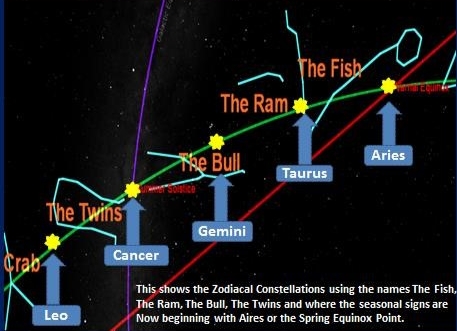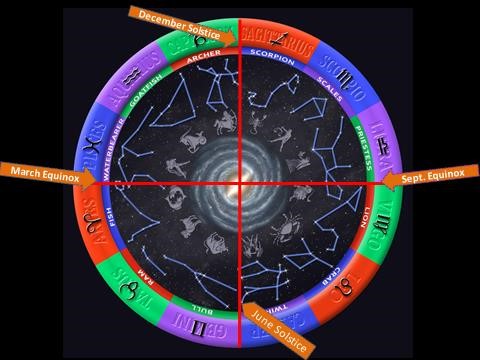Jan 22, 2023 | by Daniel Giamario |
In response to frequent questions, I am reposting my thoughts on the always fascinating understandings and misunderstandings regarding the differences between signs and constellations. Plus we will investigate the ongoing controversies about tropical and sidereal zodiacs.
The following ruminations can be digested in combination with Cayelin Castell’s excellent YouTube with lots of visuals on the difference between signs and constellations.
A Condensed History
 The world’s first zodiacs were Lunar. China, India, Arabia, Persia, and Babylonia all had lunar zodiacs prior to the emergence of solar ones. There were 27 or sometimes 28 “signs”, that were often called Lunar Mansions, or the Nakshatras in India. These groupings were defined by the visible movement of the Moon through the starry patterns from night to night.
The world’s first zodiacs were Lunar. China, India, Arabia, Persia, and Babylonia all had lunar zodiacs prior to the emergence of solar ones. There were 27 or sometimes 28 “signs”, that were often called Lunar Mansions, or the Nakshatras in India. These groupings were defined by the visible movement of the Moon through the starry patterns from night to night.
The 27 or 28 mansions of the Moon were based on the Moon’s sidereal cycle, wherein the Moon will return to any given fixed star every 27.3 days (the moon’s sidereal cycle). This system had no relationship to the phase of the Moon, or the part of the lunar cycle (based on the synodic cycle) that is repeated every 29.5 days. Many Lunar Mansion systems began marking the different segments of the sky with the Pleiades. Most of the ancient synodic systems began with the first visible crescent Moon in the evening sky just after the Sun/Moon conjunction.
Interestingly, the South Asian and Polynesian cultures developed a different Lunar Calendar system based on the synodic cycle, giving significance to the actual visible shape of the Moon from one day to the next.
Sidereal Zodiacs
Over a period of time, and for reasons that are not fully known, the emphasis of many cultures shifted to the Sun (possibly related to the emerging patriarchy). At a certain point, around 2000-3000 BC, the sexagesimal numbering system appeared in Sumeria, with emphasis on the numbers 60 and 12, originating the 360-degree coordinate system. Since the 29.5-day synodic moon cycle most closely divides into the length of the solar year with the closest whole number of 12, the concept of “months” (moonths) arose.
One way to think about this is to consider the 12 months as the 12 mansions of the Sun. Each month, the Sun traverses nearly 1/12 of the sidereal zodiac or the visible constellational patterns. Different cultures saw these star patterns in different ways and then projected stories (myths) onto them.
According to the remarkable research of the late Cyril Fagan, the original sidereal zodiac (Sumerian, Babylonian), was based on Aldebaran and Antares. Aldebaran (the Bull’s Eye), was set at 15 degrees Taurus, and Antares, rising exactly opposite to Aldebaran, was set at 15 degrees Scorpio. The rest of the Zodiac was measured off as 30 degree segments, with Aldebaran considered to be the prime fiducial.
Siderealists us the term Prime Fiducial to describe the star that determines the starting point of the zodiac. Other sidereal zodiacs have used other stars. For example, India has variously used Alpha Piscium (the Knot of Pisces) and also Spica, as prime fiducials. All these sidereal (constellation-based) zodiacs had equal 30 degree sizes.
The Essence of Constellational Patterns
In the heyday of these sidereal zodiacs, various cultures noticed the “As Above So Below, As Within So Without” connections between the starry patterns and the affairs of human beings and the world around them. All this was happening before the invention of individual personal horoscopes. Most often, the patterns noticed would be connected to seasonal phenomena, or the “Mystery Teachings” related to a time of the year that was then projected onto the constellational pattern. And each culture that projected (or received) meaning from the starry patterns in each solar mansion did so by way of the conditions of that specific place. Different cultures do not (and did not) create the same stories and images for the various constellational patterns.

Visual created by Cayelin Castell
However, what we are suggesting is that there is an essence, psychically and energetically, to the star pattern itself. Rudolph Steiner and the Astrosophists referred to these star patterns as “the bones”, or the energetic image/pattern has greater importance than the content of the image or its related story. The essence of these patterns both precedes and inspires the stories and understanding of any given culture or time. What we will see now is that these images and stories are culturally relative, and crucially, relative to the season.
Emergence of the Seasonal (Tropical) Zodiac
Over time it became apparent that the constellations would slowly shift and begin to appear at different seasons, or said another way, they stopped appearing at what was considered “the right season.” The best known example of this motion, known as the precession of the equinoxes, is how the world ages turn.
For example, around 4000 BC the stars of the Bull aligned with the Spring Equinox; then in 2000 BC, it was the Ram that was aligned with the Spring Equinox, followed by the Fish (a.k.a. Pisces), and now the Spring Equinox is drifting into the Water Bearer.
It was 130 BCE, when the Greek Hipparchus was cataloging the sky using Babylonian star charts and noticed that the stars were not in the same seasons as they were on the older charts. In addition to being credited with the “discovery” of precession, he also suggested that it would be good to have a seasonal zodiac that began with the Spring Equinox.*
That way it would be possible to have a frame of reference fixed on the seasonal shifts or Equinox and Solstice points, and not subject to the precession of the seasons through the constellations. It is interesting to note that this development also coincided with the appearance of personal horoscopes or a natal chart for an individual.
It was the genius of the Hellenistic culture that came up with this completely different zodiac, separate from the constellational zodiac. This solved the problem of the constellations (over time) appearing in different seasons. It was Ptolemy in the 3rd century AD that systematized and formalized the tropical zodiac into a comprehensive system. It wasn’t long before Ptolemy’s system became the standard, replacing several other attempts at creating a Tropical Zodiac.
Points of Interest
- The view of TOTAMS is that many ancient cultures knew about precession, and it was built into mythic history for millennium.
- Hipparchus thought that there was an oscillation back and forth, not a true precession of about 26,000 years. However, he was responsible for inspiring the authentic tropical zodiac beginning with an invariable Vernal Equinox (Spring), and that required knowledge of a precession of the seasons through the constellations.
- During the time of Alexander the Great, a tropical zodiac was devised, for the reasons previously mentioned, but the starting point was fixed at either 8 or 10 degrees of Sidereal Aries. Those were the tropical systems that reached India, influencing their astrology at the time of Alexander.
The Big Secret
In any discussion of the different zodiacs, and in the controversies surrounding tropical (seasonal) versus sidereal (constellations), we encounter the following two issues:
(1) What about the time when they were the same?
For example, Cyril Fagan in using the Babylonian sidereal zodiac, figured that the beginning of the constellation of the Ram (Aries), coincided with the Spring Equinox (the beginning of the sign of Aries in seasonal zodiacs) in 221 AD.
Anyone who asks this question ignored the fact that the two zodiacs are TOTALLY DIFFERENT, based on two different frames of reference. They never have corresponded or been the same. Plus, the original beginning of the constellational zodiac was the Bull (with the Pleaides as 0 Taurus), not Aries! But that is another story.
(2) The other objection is that the tropical (seasonal) zodiac must be wrong, because it has not taken precession into account.
For example, the sign Aries does not line up with the stars of the Ram (also called Aries).
Another example, at the time this article has been updated, April 2023: Mars has had seven months in the sign of Gemini, but has had three conjunctions with star Aldebaran, which is the eye of the Bull Constellation, and the former prime fiducial of the Babylonian sidereal zodiac! These realities inspire both astronomers and sidereal astrologers to heavily criticize tropical sign-based astrology, alleging that it has not changed with the times. But in fact, that reasoning is totally backwards.

Visual created by Cayelin Castell
The sign (or season) based zodiac is actually the fixed unchanging zodiac, tied into the actual experience of the Earth Based seasons, having originally been created because the so-called fixed star zodiac was getting out of sync! Get it?
The Grand Synthesis
When we realize we have two entirely different zodiacs without any connection, a remarkable possibility arises. We can imagine these two separate zodiacs are working together, informing each other like two great sets of gears that interact over a 26,000-year time period.
Each constellation, each pattern of “bones”, not just the projected image, has an opportunity to line up with every seasonal sign about every 2100 years. This continuous interaction over time, as an effect of precession, creates the way that myths and symbols change over time. This then describes how culture changes, sometimes gylanic, sometimes patriarchal, matriarchal, hunter gatherer, agricultural based, technological etc.
It has recently been discovered in translations from Greek texts done by Project Hindsight, that it was known at the time of Ptolemy that there were two different Zodiacs. The question Ptolemy and his school asked was “What is the proportion by which the constellation informs the sign?”
But then great confusion arose, and the Dark Ages followed.
A measure of what makes a dark age includes not knowing about precession and the reasons for two zodiacs. We still do not really know the answer to that question from Ptolemy’s school, but we Shamanic and Turning of The Ages Astrologers are always asking the question. We are committed to exploring and building a philosophical and experiential foundation to the astrology of the future. This approach synthesizes the power and magic of both zodiacs: the essence of the constellations continuously informing the seasonal Earth-centered qualities of the signs.
- Father Sky / Mother Earth
- Animus / Anima
- Spirit / Soul
- Fire and Air / Water and Earth
- Masculine / Feminine
This is an all too brief overview of a vast and complicated subject. But one aspect of being a TOTAMS Shamanic Astrologer is having the ability to answer questions concerning the differences between signs and constellations, about precession, about the Age of Aquarius, about the Galactic Alignment, and the Turning of the Ages. Our teachings, both in the form of online courses and in-person events, cover all of this and more.
The ultimate objective is to directly and kinesthetically experience the Turning of The Ages, to actually feel the great wheels of the Zodiac which are now creating a new world age. This is how we can all come together to collaborate with the process which Jung described as “Dreaming The Myth Onwards.”
